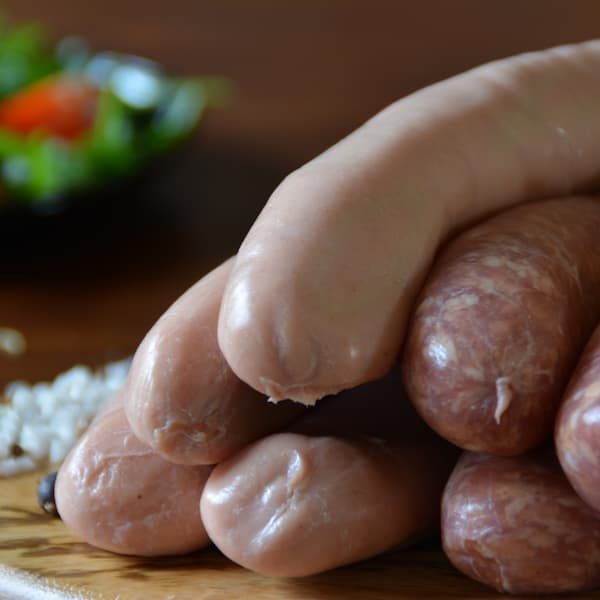Thuringian Bratwurst - Coarse or Fine
The Thuringian bratwurst has an excellent reputation far beyond the borders of the Free State. It’s a true export hit, boosting Thuringia’s recognition even internationally. As a regional specialty, the Thuringian bratwurst has been protected by the EU since 2004. Whether coarse or fine, the Thuringian bratwurst can only bear this name if it is produced in the Free State according to precisely defined guidelines. However, the raw materials and spices can come from other regions. Thuringian butchers often keep their recipes, passed down through generations, a secret—for good reason! This is how the bratwurst remains truly special.
Coarse vs. Fine - How the Sausage Filling is Made
The degree of grinding of the sausage filling, known as the "brät," determines the final consistency of the bratwurst. Different grinder plates are used during the initial grinding process. Large openings produce a coarse brät, while smaller openings result in fine brät.
The coarsely ground bratwurst originated in Thuringia and is still made here using traditional methods. Thuringian bratwurst is known for its coarse texture, achieved by the rough chopping of the meat.
If the brät needs to be further refined, it is transferred to a cutter, which processes it even more thoroughly than a meat grinder. To prevent the mixture from heating up and causing the proteins to coagulate, ice water is added.
The meat is then mixed with spices, resulting in a rich flavor. In addition to salt and pepper, spices like caraway, garlic, and nutmeg are often used. Other common ingredients include marjoram, wild garlic, mustard seeds, lemon, coriander, and paprika. The seasoned brät is then stuffed into natural casings.
Is the Original Thuringian Bratwurst Coarse or Fine?
The original Thuringian bratwurst is a medium to coarse sausage made from ground pork, with a fat content that must not exceed 25%. Additions of beef or veal are allowed. Another hallmark of the Thuringian bratwurst is its natural casing.
Coarse or Fine - The Best Way to Enjoy Thuringian Bratwurst
When the enticing smell of freshly grilled sausages wafts through the market squares and streets, it’s hard to resist. It’s clear that Thuringian bratwurst tastes best in the fresh air. Crisply browned and topped with a generous stripe of mustard, it’s traditionally served in a split bakery roll. But not just any mustard will do. Authentic Thuringian mustard is made exclusively from ground mustard seeds, vinegar, and horseradish.
If you ask for a Thuringian bratwurst topped with ketchup at a stand in Erfurt, Weimar, Jena, or Gera, you’ll quickly be marked as a tourist. Hardly any local would commit such a "breach of tradition."
When grilling Thuringian bratwurst in your own backyard or at a club event, pairing it with potato salad makes the experience complete. Of course, the potato salad should be made from an authentic Thuringian recipe. Not only does potato salad or a roll complement the bratwurst, but sauerkraut is also an excellent match for this specialty.
How to Properly Prepare Thuringian Bratwurst
When cooked on a charcoal grill, coarse or fine Thuringian bratwurst develops the flavor that connoisseurs appreciate most. Once the grill reaches the right temperature, simply place the sausages on the hot grate and brown them evenly on all sides. The charcoal grill undoubtedly provides a taste experience that gas or electric grills struggle to replicate.
Of course, the sausages can also be fried in a pan. To ensure that Thuringian bratwurst cooked in a pan matches the flavor and appearance of its grilled counterpart, a few tips should be followed:
- To give the sausage a nice brown color in the pan, first dip it in hot water. After the bath, pat the sausage dry and sprinkle it with a little salt.
- High-quality lard works particularly well as frying fat.
- Frying at medium heat will give the best results and prevent the sausages from bursting.
- Avoid turning the Thuringian bratwurst too frequently in the pan.





Leave a comment
This site is protected by hCaptcha and the hCaptcha Privacy Policy and Terms of Service apply.